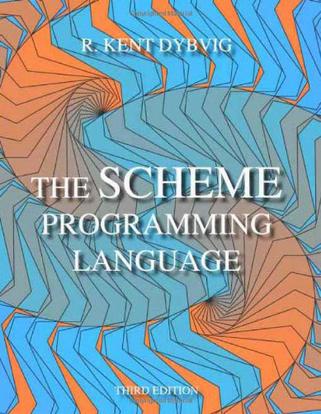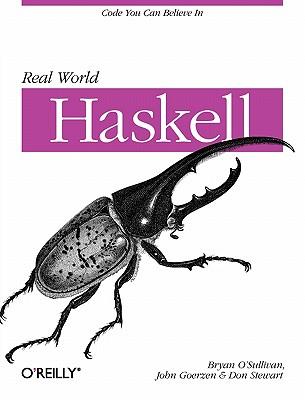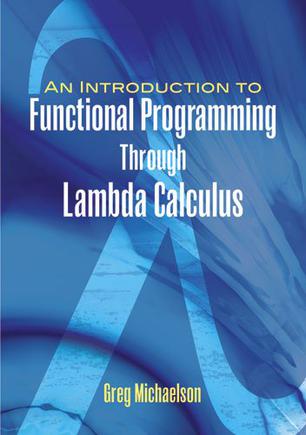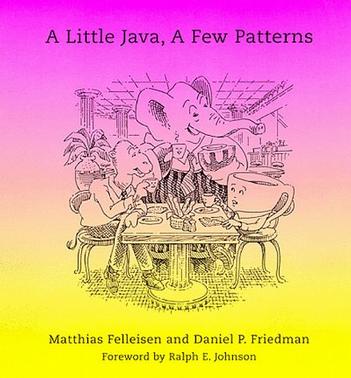-

The Scheme Programming Language
This thoroughly updated edition of The Scheme Programming Language provides an introduction to Scheme and a definitive reference for standard Scheme, presented in a clear and concise manner. Written for professionals and students with some prior programming experience, it begins by leading the programmer gently through the basics of Scheme and continues with an introduction to some of the more advanced features of the language. Many exercises are presented to help reinforce the lessons learned, and answers to the exercises are given in a new appendix. Most of the remaining chapters are dedicated to the reference material, which describes in detail the standard features of Scheme included in the Revised Report on Scheme and the ANSI/IEEE standard for Scheme. Numerous examples are presented throughout the introductory and reference portions of the text, and a unique set of extended example programs and applications, with additional exercises, are presented in the final chapter. Reinforcing the book's utility as a reference text are appendixes that present the formal syntax of Scheme, a summary of standard forms and procedures, and a bibliography of Scheme resources. The Scheme Programming Language stands alone as an introduction to and essential reference for Scheme programmers. It is also useful as a supplementary text for any course that uses Scheme. The Scheme Programming Language is illustrated by artist Jean-Pierre Hebert, who writes Scheme programs to extend his ability to create sophisticated works of digital art. -

Real World Haskell
This easy-to-use, fast-moving tutorial introduces you to functional programming with Haskell. Learn how to use Haskell in a variety of practical ways, whether it's for short, script-like programs or large and demanding applications. Written for experienced programmers, Real World Haskell takes you through the basics of functional programming at a brisk pace, and helps you increase your understanding of Haskell in real-world issues like I/O, performance, dealing with data, concurrency, and more as you move through each chapter. With this book, you will: Understand the difference between procedural and functional programming Learn about Haskell's compiler, interpreter, values, simple functions, and types Find your way around Haskell's library -- and write your own Use monads to express I/O operations and changes in state Interact with databases, parse files and data, and handle errors Discover how to use Haskell for systems programming Learn concurrency and parallel programming with Haskell You'll find plenty of hands-on exercises, along with examples of real Haskell programs that you can modify, compile, and run. If you've never used a functional language before, and want to understand why Haskell is now coming into its own as a practical language in so many major organizations, Real World Haskell is the place to start. -

An Introduction to Functional Programming Through Lambda Calculus
This well-respected text offers an accessible introduction to functional programming concepts and techniques for students of mathematics and computer science. The treatment is as nontechnical as possible, assuming no prior knowledge of mathematics or functional programming. Numerous exercises appear throughout the text, and all problems feature complete solutions. 1989 edition. -

Functional Programming Patterns in Scala and Clojure
Functional languages have their own patterns that enable you to solve problems with less code than object-oriented programming alone. This book introduces you, the experienced Java programmer, to Scala and Clojure: practical, production-quality languages that run on the JVM and interoperate with existing Java. By using both the statically typed, type-inferred Scala and the dynamically typed, modern Lisp Clojure, you’ll gain a broad understanding of functional programming. For each pattern, you’ll first see the traditional object-oriented solution, and then dig into the functional replacements in both Scala and Clojure. These patterns are common in the functional world and deserve to become part of your problem-solving toolkit. On the object-oriented side, you’ll see many common patterns, such as Command, Strategy, and Null Object. On the functional side, you’ll learn core functional patterns such as Memoization, Lazy Sequence, and Tail Recursion. Each pattern helps you solve a common programming problem. Working through them gives you a set of patterns you can use to solve problems you come across while writing programs. Finally, you’ll learn how to work your existing Java code into new Scala or Clojure projects. You can start off small, adding functional code little by little, so you can complement your existing knowledge with Scala and Clojure as these languages gain popularity on the JVM. -

Erlang 程序设计
书是讲述下一代编程语言Erlang 的权威著作,主要涵盖顺序型编程、异常处理、编译和运行代码、并发编程、并发编程中的错误处理、分布式编程、多核编程等内容。本书将帮助读者在消息传递的基础上构建分布式的并发系统,免去锁与互斥技术的羁绊,使程序在多核CPU 上高效运行。本书讲述的各种设计方法和行为将成为设计容错与分布式系统中的利器。. 在多核、并发、分布为王的时代,谁将成为下一个主流编程语言?来自全世界的众多专家都认为,Erlang最有可能在竞争中胜出。 Erlang开源语言系出名门,通信巨头爱立信公司用它开发出了可靠性惊人的交换机系统AXD301。它天生就是面向并发、分布和高容错的,兼有函数式语言和脚本语言的各种优点,而且已经用于商业开发多年,具有稳定性极高的虚拟机和平台库。有了这些天时地利,无怪乎Erlang能够迅速成为热门的开发语言,除了广泛应用于通信行业之外,它已经进入了各个领域:Facebook用它实现了聊天系统,Yahoo用它重写了Delicious,Amazon用它开发了云计算数据服务SimpleDB,还有多人游戏、测试工具、电子支付、数据采集与监控、企业消息、电子邮件、空中交通管制…….. 本书由Erlang之父Joe Armstrong编写,是毋庸置疑的经典著作。书中兼顾了顺序编程、并发编程和分布式编程,较深入地讨论了开发Erlang应用中至关重要的文件和网络编程、OTP、MNesia、Ets和Dets等主题,更为精彩的是,大师亲自操刀,构建了MapReduce实例和多人聊天实例,一定让你大呼过瘾。... -

A Little Java, A Few Patterns
Java is a new object-oriented programming language that was developed by Sun Microsystems for programming the Internet and intelligent appliances. In a very short time it has become one of the most widely used programming languages for education as well as commercial applications.Design patterns, which have moved object-oriented programming to a new level, provide programmers with a language to communicate with others about their designs. As a result, programs become more readable, more reusable, and more easily extensible.In this book, Matthias Felleisen and Daniel Friedman use a small subset of Java to introduce pattern-directed program design. With their usual clarity and flair, they gently guide readers through the fundamentals of object-oriented programming and pattern-based design. Readers new to programming, as well as those with some background, will enjoy their learning experience as they work their way through Felleisen and Friedman's dialogue.